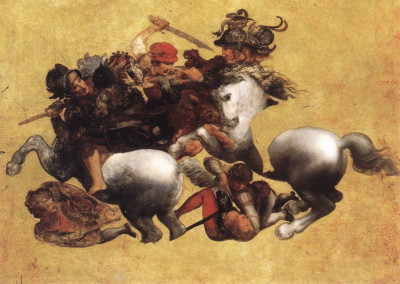The Battle of Anghiari is a painting by Leonardo da Vinci that still remains something of a mystery. It is now believed that the final work was never completed, despite the master having produced a number of preparatory drawings for this piece.
Introduction
This planned piece has been well documented because of the number of copies of it that were produced by other artists, including the highly regarded Peter Paul Rubens. It is from those that we can glean much about how the final piece would have looked, were Da Vinci to have completed it. Recent research has concluded, fairly confidently, that Da Vinci never finished the oil painting.
This was clearly a prestigious commission, for the artist to produce so many study drawings, and in such great detail. Many portraits have been uncovered of individual figures from the overall composition. These alone have received considerable praise, and there are likely to have been more at the time that have since been lost, damaged or left undocumented.
Walter Isaacson, in Leonardo da Vinci - The Biography, devotes an entire chapter to this significant project. He claims that, if successfully completed, Da Vinci's The Battle of Anghiari may have been as artistically impressive as The Last Supper, only with a greater freedom of expression thanks to the avoidance of having to conform to religious scripture.
The author, within this exceptional biography, outlines how The Battle of Anghiari fits into the overall battle between Leonardo and Michelangelo. It was rare for their paths to cross as closely as this, but there had always been aware of each other from afar. They held a begrudging respect for each other, whilst each considering themselves the master of the other.
It must also be remembered that war played an important role within art content during the Renaissance and Baroque eras, particularly in Italy and the Netherlands. Da Vinci was already a highly accomplished sketcher of horses, as well as the human anatomy, and so this composition would not have daunted him at all. Sadly, there many artworks which were never finished right across his career, for a variety of reasons including politics around a commission, to relocations by the artist to other parts of Italy.
The painting was never completed and would eventually be destroyed in the 16th century, leaving us with a suggestion of what might have been thanks to a large number of copies by other artists. The image displayed here is believed to have been a copy by Tavola Doria, many years before Da Vinci's version was damaged beyond repair. The Battle of Anghiari remains an exciting topic within the artist's career, but one that leaves us frustrated at what might have been.
This article examines Da Vinci's role in this project, and the potential painting that he may have left uncompleted. We will browse his study drawings for this complex composition, and also discuss the commission, and how it forced him to work alongside other artists, including Michelangelo. Finally, we detail the research projects which have attempted to reveal whether the piece was ever completed, and where it might reside today if is still exists.
Table of Contents
- Introduction
- When was The Battle of Anghiari?
- Commission
- The Battle of Anghiari Study Drawings
- Leonardo V Michelangelo - the Battle of the Old Masters
- Description
- Size and Medium
- The Battle of Anghiari Left Unfinished
- Large Image of a Copy of The Battle of Anghiari
- References
When was The Battle of Anghiari?
The Battle of Anghiari was fought on the 29th of June, 1440. Da Vinci would receive a commission based on this event some sixty years later, in late 1503.
The battle was part of the wider Wars in Lombardy, and was fought between the Milan against a collection of Italian states, with Florence being the most prominent of those. Anghiari is a hillside town in Tuscany and played host to this significant battle. Both sides boasted several thousands soldiers, with the Milanese side having marginally more men to call upon.
Despite their additional manpower, the Milanese side would be out manouvered, and eventually lost the battle. This conflict lasted only a day, but would be covered in many battle depictions by Italian artists. This resulted in the event gaining something of a legendary status, even though it was just one part of a wider conflict.
Commission
Leonardo da Vinci was commissioned in October 1503 to produce a depiction of The Battle of Anghiari to be hung in the Salone dei Cinquecento (Hall of the Five Hundred) in the Palazzo Vecchio in Florence, Italy. The palace is located alongside the famous Piazza della Signoria in the centre of the city.
This highly significant commission could potentially have been the highlight of Da Vinci's entire oeuvre, were the painting ever finished. Michelangelo was chosen to produce a painting within the same hall a year later, but rather than collaborate together, the two saw this as an opportunity to prove their mastery over the other.
Subject
The Battle of Anghiari was chosen as the subject matter because of how well the Florentine forces had faired within this battle, ultimately achieving victory with fewer men than their opponents. Celebrating such successes was important in building confidence within a state regime, and so depicting them in art could help to strengthen the resolve of the local population.
The Battle of Anghiari Study Drawings
Around a dozen study drawings have been uncovered which directly relate to Da Vinci's preparation for the Battle of Anghiari painting that went unfinished. They reveal much about how the artist intended to compose this piece. Initially, it seems, he was intending to capture several different scenes together in the same composition. This was a major commission, perhaps his biggest of all, and so the great master wanted to deliver something that challenged him, but also helped cement his own legacy.
The artist would later decide to focus on a single scene, and this is what was later copied by other artists, including Rubens. Whilst reducing the scope of the composition, the detail would still be extraordinary and you will see from the drawings below that each and every figure was considered in detail by the artist. He would sketch portraits individually in considerable detail, leading less need to amendments once he started to paint.
The final piece would have been an incredible size, and many metres wide. That is why he would go into so much detail on each and every figure individually. Up close, one would have been able to make out these details, because of the momentous size of the artwork. Some have argued that The Battle of Anghiari would have been close to sixty feet wide, based on the dimensions of the room in which it was to be displayed.
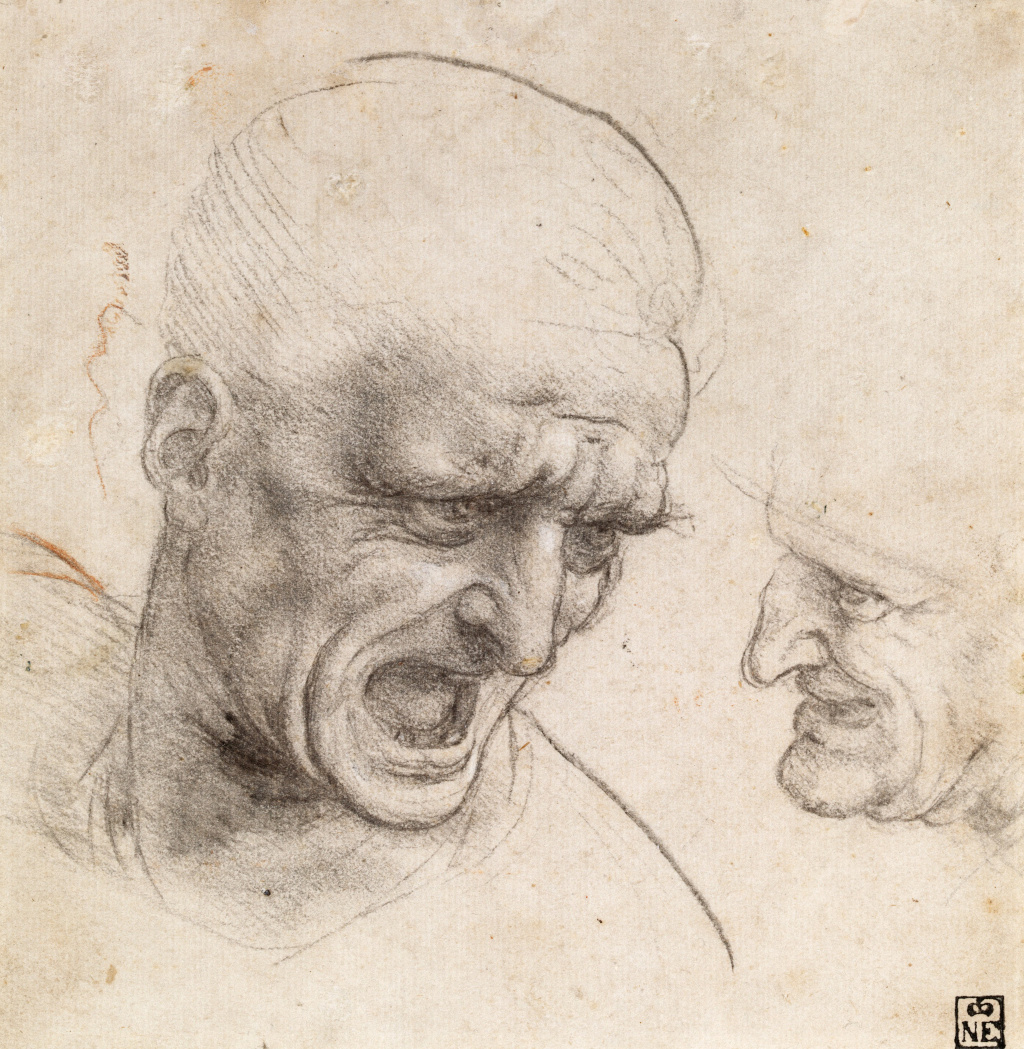 Study of Two Warriors' Heads for The Battle of Anghiari
Study of Two Warriors' Heads for The Battle of Anghiari
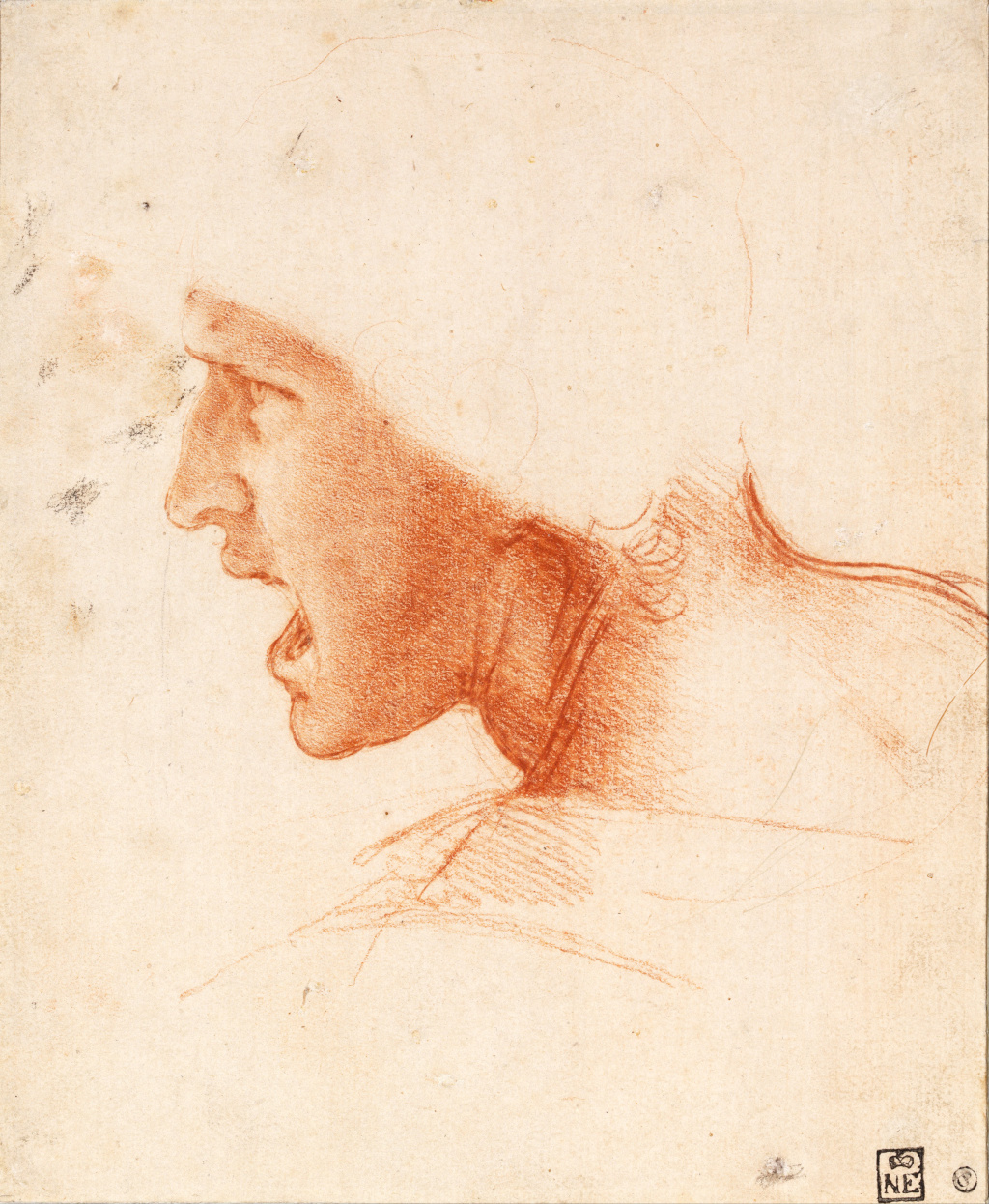 Study of a Warrior's Head for the Battle of Anghiari
Study of a Warrior's Head for the Battle of Anghiari
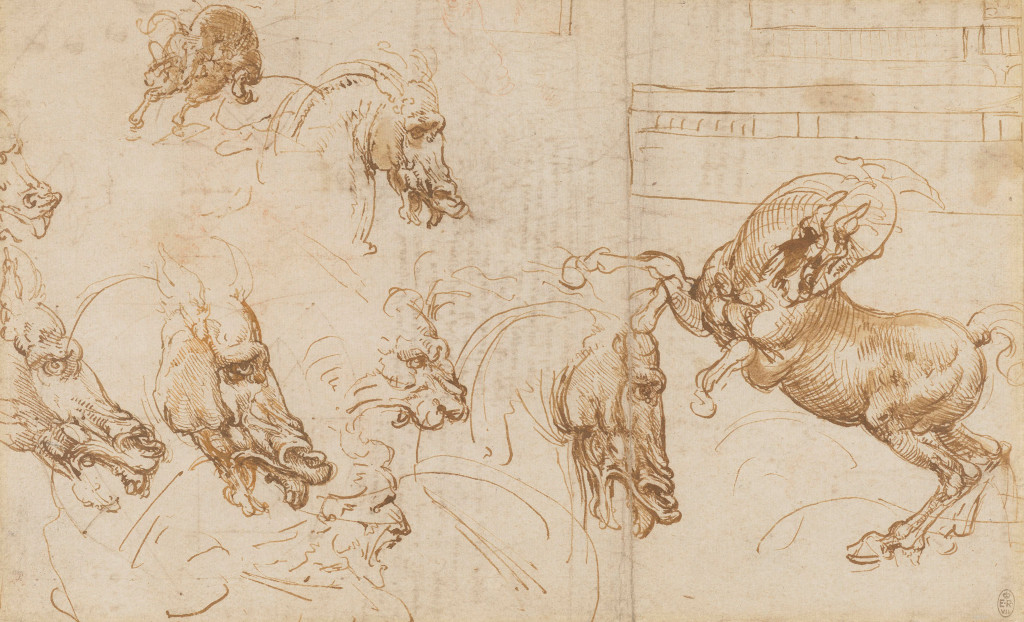 Expressions of Fury in Horses, a Lion and a Man
Expressions of Fury in Horses, a Lion and a Man
Leonardo V Michelangelo - the Battle of the Old Masters
This would be the ultimate battle of the masters, that never was. Neither Michelangelo nor Leonardo da Vinci would ultimately complete the paintings for which they had been commissioned. Both produced extraordinary drawings that still today wet our appetite of might have been, and the unfinished paintings were also well received.
Michelangelo continually treated Leonardo with disrespect, despite being far younger. He would mock the master over failed projects, rather than seeking to learn from his equally skilled colleague. Leonardo felt uncomfortable around the arrogant understudy and became unwilling to deal with him, just as many patrons had also concluded. The two would disparage each other's work, with Leonardo describing the heavily toned muscles in Michelangelo's work as reminiscent of walnut shells.
Ultimately, their work within the hall would bring great pressure - an opportunity to out do each other. Perhaps this was the cause of Leonardo working too slowly to complete his commission, so desperate he was to out perform his rival. As opportunities arose elsewhere, they would both more on, leaving behind a series of exceptional drawing studies and Leonardo's incomplete work in oils.
Description
Leonardo's powerful scene delivers a complex maze of detail, with contorted bodies and emotion-filled faces. The master chose not to depict the horrors of war, nor the elation of victory and instead focused on providing emotion at its maximum level. The facial expressions were a key element of this, and that explains why the artist spent so much time drawing preparation portraits of individual figures, prior to starting the main painting.
Whilst the incomplete oil piece was destroyed many centuries ago, we can faithfully refer to the copies made of it in order to understand how it would have looked. Rubens' detailed drawing is perhaps the most famous copy and offers considerable detail. There are multiple horses within the scene, with soldiers on horseback, holding their weapons in the air. Others lay on the floor, seemingly in desperate straits.
Vasari, a respected Renaissance-era historian, did see Leonardo's unfinished painting with his own eyes. He described the incredible precision used by the artist, and particularly the emotional impact delivered by this piece. He acknowledged the qualities of Leonardo in depicting muscle balance, as well as the anatomy of the horse. He was, in summary, particularly impressed by what work had been completed, and shared our frustration that it would never be finished.
Size and Medium
According to Walter Isaacson, Leonardo chose to complete this painting slightly differently to the Last Supper, in part because of how he could already see that piece deteriorating. The artist continually ran into problems painting directly onto walls and this is why most of his famous works were on wood panels, which have faired much better over the centuries. Da Vinci used oils for this painting, enabling brighter, stronger tones which he much preferred.
The original location intended for this piece allowed a stretch of nearly sixty feet wide, and this was the intended dimensions of Leonardo's The Battle of Anghiari. This was an extraordinary undertaking, and even with the considerable resources given to the artist for this commission, his use of oils in a subtle manner, with endless tones and glazes, ensured that he could not complete this piece on time. Eventually, the entire project was abandoned, but with the incomplete painting still placed out on display, to considerable acclaim.
The Battle of Anghiari Left Unfinished
Leonardo would eventually abandon the project, just as Michelangelo would with his work. The most likely reason for Leonardo moving on was his continued difficulties in applying oil successfully to the hall wall. He was not confident that the colours would set in the way he wanted, and he would already have been anxious after the issues suffered by the Last Supper in the years after he completed that piece. He also seemed unsettled by the presence of the young Michelangelo within the hall, who would witness his continued technical problems.
Large Image of a Copy of The Battle of Anghiari
For those looking to understand more about Da Vinci's original work, a larger version of the copy is included below. As you can see, much of the detail is left entirely blank, but the elements that were completed are enough by themselves to get a decent understanding of how the original piece may have looked, as well as what the planned composition would have looked like were it finished.
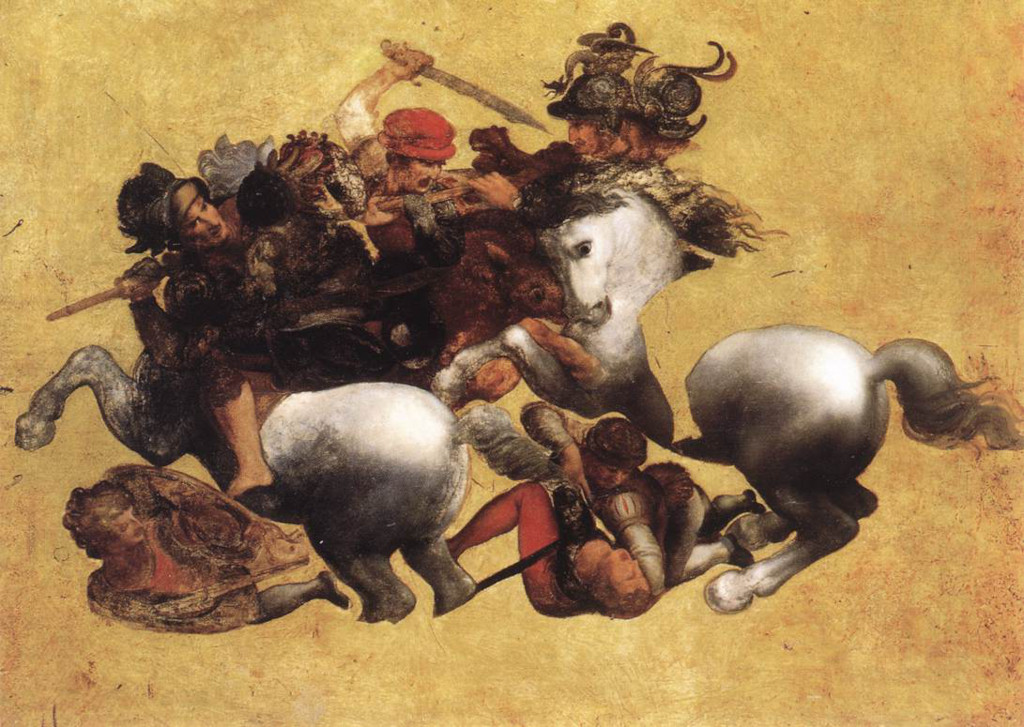 Copy of The Battle of Anghiari, possibly by Tavola Doria
Copy of The Battle of Anghiari, possibly by Tavola Doria
References
- Leonardo. The Complete Paintings and Drawings, Frank Zöllner & Johannes Nathan, Taschen
- Leonardo da Vinci, Walter Isaacson



